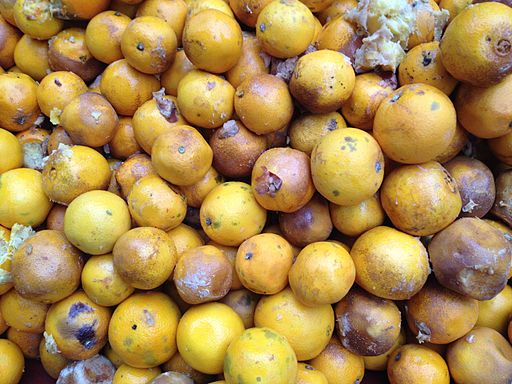
Artificial preservatives have become so common in our food that most of us don’t even question their presence.
We hardly bat an eye when we see something like ascorbic acid—one of the more common man-made preservatives—on an ingredients label.
In reality, these substances have detrimental effects on our health, especially on the friendly bacteria populating our gut. If we are at all interested in being as healthy as possible, we should be eliminating them from our diet.
The first step in grasping the reasons for preservatives is understanding food decay. Then, we can look at the two types of preservatives we find in our foods, and what their impacts have on a gut level.
The Two Processes that Cause Food Decay.
We can easily observe the process of food decay by placing a piece of ripe fruit, an apple for example, on the counter top and watching what happens. The browning and rotting of the apple is the result of two different processes.
>> The first is a process known as oxidation. This is simply a natural chemical reaction that takes place when organic material, in this case the apple, is exposed to oxygen.
>> The second process causing the apple to decay is carried out by microorganisms. Bacteria on the outside of the apple begin to “eat” it. These bacteria enjoy apples just like humans do, and it is a great food source for them. As long as there is a continual supply of oxygen and a reasonable supply of nutrients, such as those provided by the apple, bacteria will continue to multiply and break down the organic material.
Why Preservatives are in our Food.
The role of preservatives in our foods is to stop the processes of oxidation and bacterial growth. This might sound like a good thing, and it is, depending on which types of preservatives are being used. Preservatives can be placed into two different categories: natural and man-made.
>> There are many different types of natural preservatives. Acids, like citrus juice, for example, prevent the oxidation of food. Salt is another natural preservative that has been used for thousands of years. Oils and vinegars are also common natural substances used to preserve food.
>> Unfortunately, most of the preservatives used in our foods today are unnatural chemical substitutes. You’re not alone if you look at the ingredients label on a package of food and wonder, “what the hell is butylated hydroxytoluene?” There are many foods on the market today in which half of the ingredients on the label are almost impossible to pronounce. The average person most likely has no idea what any of these substances actually are, and some of these chemical compounds are man-made preservatives. Some examples of how preservatives appear on the ingredients label include: sodium sulfite, sodium nitrate, sulfur dioxide, citric acid and butylated hydroxytoluene.
How Man-made Preservatives Affect our Bodies.
To put it simply, preservatives kill bacteria. But that’s a good thing right? Don’t bacteria make us sick?
While some strains of bacteria do lead to illness, there are trillions of bacteria living inside our bodies right now, which are actually benefitting our health. For example, there are bacteria in our intestines that help us to break down food and absorb the nutrients from our food.
Here’s the catch: Man-made preservatives do not distinguish between good and bad bacteria. Imagine we have a hostage situation. There are five bad guys holding 100 innocent people hostage. We can’t just drop a bomb on the whole building just to kill the five bad guys. The same goes for our bodies. Eating preservatives is like bombing our intestinal tract because these preservatives kill both our good and our bad bacteria.
The destruction of our good bacteria has a number of negative effects on our health.
One major effect is our diminished ability to digest and break down food. Food needs to be broken down into tiny pieces in order to be absorbed through the lining of the small intestine, and our good bacteria play a major role in this process. This is just one of the many positive benefits achieved by cultivating a healthy population of bacteria in the body.
For anyone looking to learn more about this subject, I would suggest reading Clean Gut by Alejandro Junger. This book goes into detail on how our gut bacteria play a major role in our health, and how consuming preservatives severely damages our well being. [1]
Some Preservatives are Disguised as Healthy Vitamins.
Sometimes preservatives can be presented in tricky ways. A great example of this is Vitamin C.
Most Vitamin C found in our foods is actually not the naturally occurring Vitamin C found in oranges, for example. This form of Vitamin C has the chemical name ascorbic acid and is derived from synthesized corn syrup—corn, which has a high probability of being genetically modified. This topic could be a whole article on its own, so I will save the details. But the main point is that there is a major difference between the Vitamin C found in natural whole foods and the synthetic form of Vitamin C known as ascorbic acid, which acts as a preservative killing off our healthy gut bacteria. [2]
So what about natural preservatives? Don’t they have the same negative impact on our good bacteria?
The answer is no, because most natural preservatives are easily digested and assimilated into the body, have nutritional benefits on their own, and can even promote the growth of healthy bacteria.
Garlic is a great example of this; it can be used as a natural preservative. It extends the freshness of food because of its antimicrobial and anti-fungal properties. The amazing thing about garlic is that it fends off bad bacteria while simultaneously creating conditions in the body that actually promote the growth of healthy bacteria. [3]
When I first discovered this information, I completely changed my diet and became hyper-vigilant about what I was eating.
Some people might say that I took eliminating preservatives from my diet to the extreme. A few of my friends would even tease me, saying things like, “Hold on, are you sure you can eat that because there might be preservatives in there?” This demonstrates the attitude most of us have toward preservatives.
We have become so conditioned by society to accept that chemical preservatives are a natural and necessary ingredient in our foods that when I became adamant about eliminating them from my diet, my friends thought that I was being ridiculous. However, once we begin to realize how detrimental these substances actually are to our internal environment, we can see that eliminating preservatives from our diet is far from ridiculous. It’s actually an especially important step toward achieving true health and vitality.
The best way to avoid man-made preservatives is to consume fresh, whole and natural foods.
Other common natural preservatives include lemon juice, hot spices (such as cayenne pepper), and sea salt. In addition to purchasing food containing only natural preservatives, the best way to maintain a food’s freshness is to place the item in an airtight glass container in the fridge. Try to avoid plastic containers because plastic actually “breaths,” letting in some small amounts of air, which contributes to the oxidation process.
When we become more aware of the ingredients in our foods, we can better detect foods that might contain man-made preservatives and could potentially harm our bodies and decrease our quality of health.
~
References:
~
Author: John Miller
Images: Wikimedia Commons & Ryan Mcguire/Gratisography
Apprentice Editor: Sarah Crosky; Editor: Khara-Jade Warren
~











Read 0 comments and reply